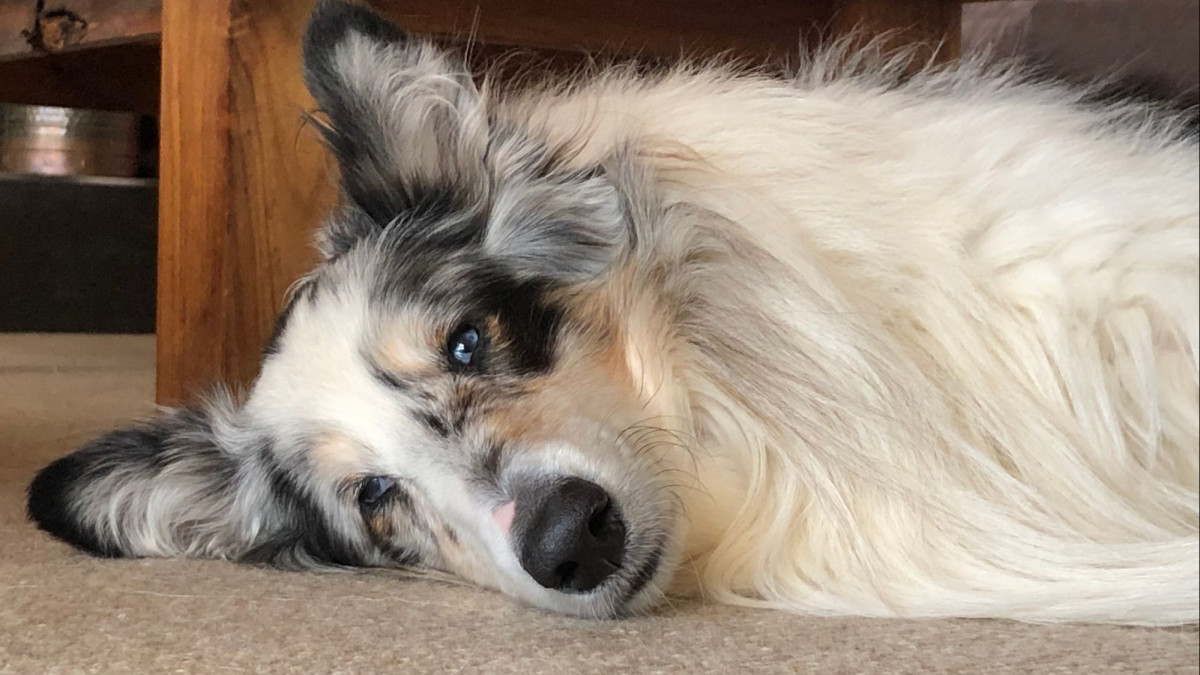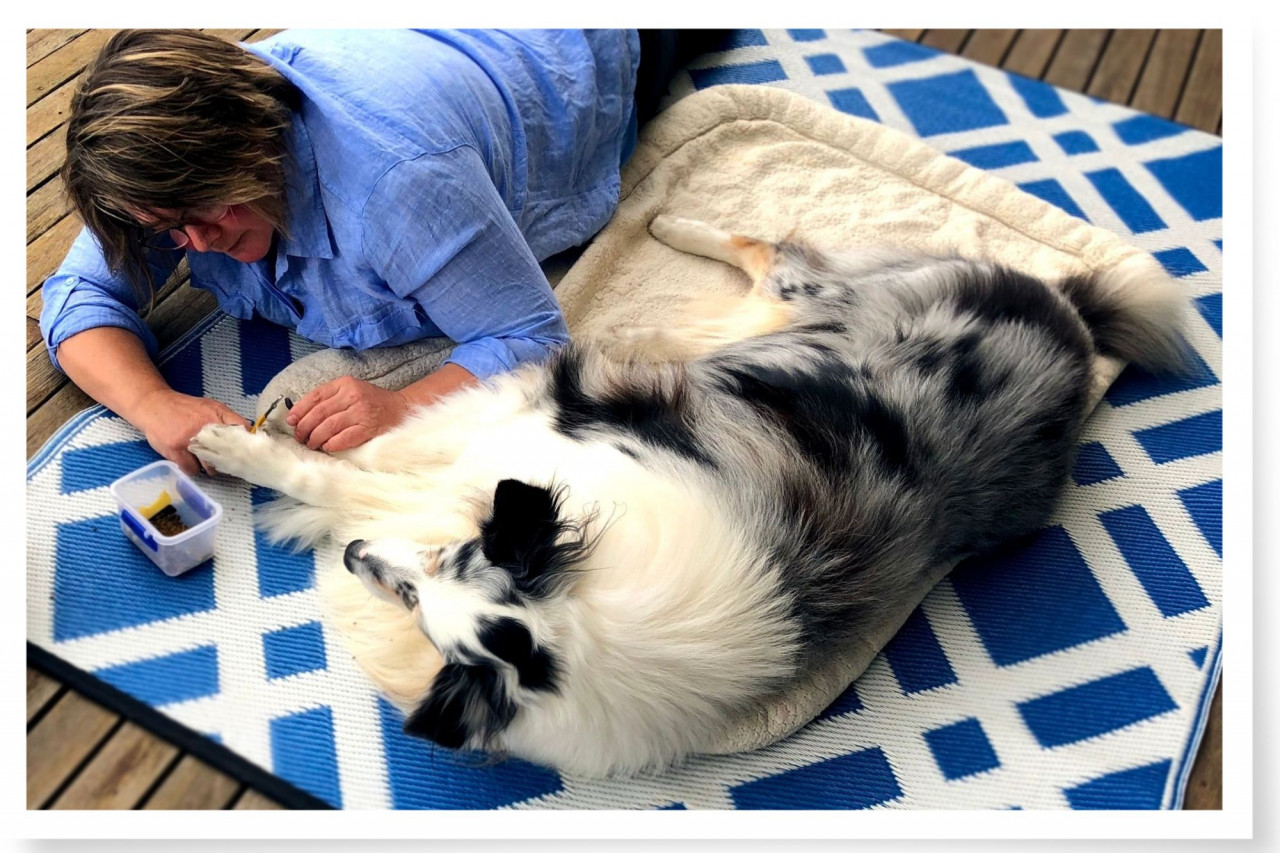For all the dogs who've touched our hearts
How to teach a dog to lie on the side

Lie on the side is a useful and fun behaviour to teach your dog. Learn how in this practical guide.

For lumps, bumps and something fun to do
'Lie on the side’ is a great behaviour! Teach ‘play dead’ and impress your friends by adding a cue like “BANG!” More importantly lie on the side is useful for husbandry procedures such as trimming nails and hair, brushing, and checking for lumps and grass seeds.
Dogs already know how to lie on the side, the trick is to do it on cue! Today’s blog and video tutorials share how to teach this fun and valuable behaviour. It’s not hard to do and is suitable for most dogs.

Teach a dog to lie on the side for connection


Connection grows when we choose methods that respect, support and motivate our dogs and when we apply them with skill.
Julie - Delight in Dogs
Husbandry, or caring for coat, skin, eyes, ears, teeth and nails, can be stressful for both dog and person. You know it’s for their own good, if only your dog understood!
Husbandry can be so difficult that many people just give up.
This is where knowledge and practical skills boost connection: more competence means less anxiety. You need however, to be realistic: skills are not acquired overnight and some dogs are more sensitive than others.

Lie on the side makes trimming Merlin's nails easier - it took time to get to this point.

Teach 'lie on the side': pop in a pot and stir?
‘How-tos’ are about sharing recipes: step 1 – do this, step 2 – do that, pop in a pot and stir. Wait 10 minutes and voila! Out comes the perfect dog. The teacher can make it look easy because they have years of experience with mastery over tiny, now intuitive, skills.
Bear this in mind if you try to teach “lie on the side’ and it doesn’t work. These videos, or recipes, need to be adapted to your dog. Refer to 5 essential questions to ask before you train your dog to help with a plan and you can find solutions to common problems in Trouble shooting at the bottom of the blog.

Let's get started!
You need
- A bowl of food: about 60 small, moist pieces that the dog can eat quickly – chewing will slow down training. Make sure the food is not sticky or slimy because you need to be able to hold and deliver with ease. Refer to Choosing and preparing food for successful dog training for more information.
- A place to keep your food reserve such as a chair or a table
- A place to train that is quiet and free from distractions: the dog needs to feel safe.
- A comfortable surface such as a mat, rug or carpet.
Tutorials

1: How to teach a dog to lie on the side

2: Changing from a lure to a hand cue

Trouble shooting
Q. What if my dog won’t lie down?
A. Teach a settled down first, here’s a video explaining how: How to teach a settle down
Q. What if my dog bites my fingers?
A. Taking food gently is an important and vital skill for both dog and person. Take the time to learn this and your training will be easier. Refer to the following blogs for information and teaching steps. Dog mugs for food? Here’s what you need to know and Stop your dog mugging for food: a practical guide
Q. Why should I give my dog so many pieces of food when they will roll over for just one?
A. Luring a dog onto their side throws them off balance. Feeding multiple pieces allows the dog to gradually adjust their weight and move into position while feeling secure. It gives you the opportunity to assess their comfort levels and support them by slowing down the process if they need more time.
Q. What is the best type of food to use?
A. Something that is moist and will hold its shape when cut into small pieces. You also want it to be healthy as you will use a fair bit. Refer to Choosing and preparing food for successful training for more information.
Q. Why does my dog keep standing up?
A. Reason 1: the dog is uncomfortable lying down like this. Slow down, expect less and feed more food for each step. You will be able to tell how they are feeling by their willingness to remain in position. Never force them.
Think about if it’s worth teaching lie on the side at all; there are plenty of other behaviours that may better suit your dog. Refer to 5 Essential questions to ask before you train your dog for some guidance.
Reason 2: the dog needs to learn duration, or time in the position. Do this by working on the settled down first (see this video) and build time remaining in the down. Then work on lie on the side and give extra pieces of food in the side position. Make sure you give a clear cue to let the dog know they can stand up (such as All done and throw a piece of food away)
Q. How do I get rid of the food, teach a different cue, get the dog used to brushing etc.?
A. Great questions! These will be addressed these in future blogs.
Thanks to Tasha James for the cute pic of Merlin featured in this post!

Further reading
When the time is right, Kay Laurence. A discussion on the pace of teaching our dogs, is fast right? “As a teacher I want to see my learner bloom and shine, have time to connect and enjoy their pleasure in learning. I want to explore who they are in this process.”
Timing and attention matter in dog training, Dr Zazie Todd PhD. “Analysis of videos of dog training sessions show that getting the dog’s attention and good timing of rewards are linked to better results.“
My dogs don’t know sit!, Eileen and Dogs “What if your dog’s cue for a behavior is not what you think it is? Can you be sure—absolutely sure—that the dog really understands what you want?“
Set your dog up for success, make training easier, delight in dogs. Learn the techniques that make it possible to train your dog with greater success, less problems and more enjoyment for you both.

You might also like



Comments

Comments
Never miss a thing!

 Julie van Schie
Julie van Schie 



